About the Australasian Philatalic Traders' Association
Contents About APTA
1. Australian Stamp Dealers' Association - The Early Years
2. How to contact APTA
o o o O O o o o
Australian Stamp Dealers' Association - The Early Years
by Richard Breckon
Stamp dealers are the lifeblood of the hobby. Without dealers stamp collecting would not exist, or at least, not exist in any meaningful sense. Collectors depend almost exclusively on dealers as a source of supply of stamps and other philatelic items for their collections. The healthy growth of the philatelic market depends on the activities of dealers and theirability to function freely.
Sixty years ago, the Australian Stamp Dealers' Association (ASDA) was founded to ensure that the interests of stamp dealers were better protected and that the stamp market continued to prosper. Today, the Australasian Philatelic Traders' Association (APTA) - the new name adopted by ASDA in 1998 - has achieved much during its more than half a century's existence. APTA remains the premier body representing the interests of all those involved in servicing the needs of stamp collectors.
During the late 1940's, the stamp market in Australia was undergoing a boom. Collectors with wartime savings and earning higher wages had more income at their disposal and more money to spend on stamps. Prices rose steadily and dealers were busy buying and selling stamps to meet the requirements of an expanding base of collectors. Following the creation of the Stamp Advisory Committee in 1947, the Post Office became more active in issuing new stamps, which provided (in those days at least) an underlying element to sustain collectors' interest. Fifty years ago, Australia supported over 100 full time and part time stamp dealers, based on the advertising in the Australian Stamp Monthly. There was even a publication catering to the needs of the trade - The Australian and New Zealand Stamp Trader, which appeared monthly during the late 1940's.

The first meeting of the Australian Stamp Dealers' Association ('Australasian' was substituted in 1959 to embrace New Zealand dealers) took place in September 1948 at Scott's Hotel in Melbourne. The Association's logo first appeared that month in the advertisements of its charter members. Curiously, no other reference was made to ASDA's creation in the editorial pages of the Australian Stamp Monthly. From its inception, ASDA met on a monthly basis in Melbourne. The Association was a national body in name, but in practice its activities were centered in Melbourne and its office-bearers were invariably Melbourne dealers. Naturally, it was Melbourne dealers who attended and voted at monthly meetings, although any visiting inter-state members could also participate in the meetings.
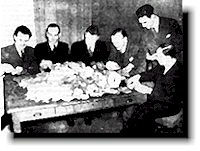
ASDA members help radio announcer and philatelist, Ray Chapman (standing), package stamps for the 3AW Invalid Corner Stamp Appeal. Seated (left to right) - A. Cumming (C.J. McDonald); P J Downie (Myer Philatelic Dept.); F. Thornhill jnr (Australian Stamp Auctions) and G.F. Reese (Orlo-Smith & Co.) (photo 1949).
Indeed, there was no executive, as such - all members participating at monthly meetings voted in the deliberations. Usually about 15 dealers attended a meeting. There were two elected positions - President and Secretary. The inaugural president was J.L. Phillips (Wallace Stamp Co.) and the inaugural Secretary was A.M. Cumming (G.J. McDonald stamp dealer).
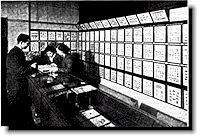
The scene inside CJ. McDonald's stamp shop, advertised as being the largest display of stamps in Melbourne. (photo c.1949).
Both firms and individuals could be members of ASDA. An annual general meeting was held usually in September at which the President, Secretary and auditor were elected and the year's balance sheet was presented. During ASDA's first year of existence, income of £227 was earned chiefly from subscriptions and expenditure amounted to only £80, leaving a healthy bank balance of £147.
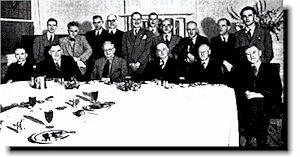
The Victorian section of the Australian Stamp Dealers' Association are pictured at a dinner held prior to the monthly meeting. The photograph was taken in late 1948, just a few months after the Association was established. Pictured in the group are standing (left to right) - J. Lewis (R. W. Turk); R. W Turk; G. F. Reese (Orlo-Smith - Co); C. Dunbar (Myer Philatelic Dept.); J.L. Phillips (Wallace Stamp Co.); H. Wheeler; F. H. Feibes; R. C. Walker; P.J. Downie (Myer Philatelic Dept.); A. Cumming (C.J. McDonald); seated (left to right) - R. W. Wilson (Stamps and Coins) - F.A Thornhill snr; H. B.R. Meyer (Orlo-Smith - Co); A.A. Rasmussen (Australian Stamp Auctions); William Ackland and Frank Thornhill jnr. (Australian Stamp Auctions).
Foremost amongst matters that concerned ASDA members was the question of retail price levels applying to stamps and accessory products. Dealers who undercut other dealers by offering stamps at cheaper prices might have been popular with their clients, but they did not earn the thanks of other dealers.
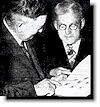
Frank Thornhill snr. at left was a charter member and President of ASDA front 1949 to 1952 (photo c.1950)
The Association's President, Frank Thornhill snr. expressed his views on the matter at the November 1948 meeting:
"Price cutting is the result of either bad buying or overbuying and the resultant shortage of liquid cash. Price cutting kills any business and a comparison of the dealers operating today with the dealers operating 5 to 10 years ago reveals that most of those who have gone out of business are the ones who began slashing prices. Mr. Thornhill did not advocate any price fixing, first of all because it is definitely impossible - the methods and ability of each dealer must be the deciding factor, but he certainly thought that any dealer who deliberately arrived at a price by cutting a competitor's offer would never be able to make a decision for himself."
A particular source of concern to ASDA involved those dealers and book-sellers who offered stamp catalogues for sale at less than the recommended retail prices. In those days, retail price maintenance was an accepted business practice and those who did not conform could expect pressure from competitors and suppliers to fall into line by charging the specified prices. ASDA approached dealers involved in discounting catalogues and asked them to adhere to the recommended retail prices.

"And remember, if you don't locate all the Coronation issues I ordered, I'm going to crown you!" ( Courtesy "Stamp Wholesaler" )
In January 1953, ASDA lost its oldest, inaugural member with the death of William Ackland at the age of 80.
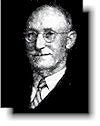
William Ackland (1872-1953) was the senior, charter member of ASDA, having operated a stamp business in Melbourne for 60 years.
Ackland had operated a stamp business in Melbourne since 1892 and over a period of 60 years he had accumulated a wealth of knowledge and experience to share with his customers and fellow dealers. Today, the only ASDA charter members still alive are Ken Baker of Sydney (Baker & Moloney) who still plays an active 'behind the scenes' role in the stamp trade.
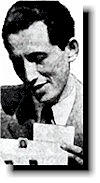
Max Stern joined ASDA in 1950. He is the longest serving member who is still active in stamp dealing (photo c.1950)
The longest serving ASDA member, who is still active in stamp dealing is Max Stern, whose firm is arguably the largest retail philatelic operation in Australia. Max Stern was admitted to membership of ASDA in February 1950. He had arrived in Australia in 1948 from Czechoslovakia and created a niche business in Australia by wholesaling world new issues to the trade. It is a measure of Max's enthusiasm and ability that within six months of his joining ASDA, he became its Secretary.
Bill Hornadge of Dubbo, NSW, was admitted to membership of ASDA in June 1952. His mail order firm, Seven Seas Stamps, grew to become the largest of its kind in the Southern Hemisphere.
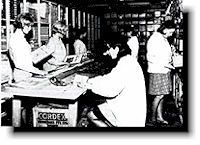
Bill Hornadge joined ASDA in 1952 and two years later he launched 'Stamp News'. His mail order firm, Seven Seas Stamps, was the largest of its kind in the Southern Hemisphere and did much to encourage children to take up stamps (photo c. early 1960s).
The firm recruited a large proportion of Dubbo's population to assemble enormous quantities of stamp packets required for the Australian market. In 1954, Hornadge launched Stamp News to provide dealers and collectors with an alternative, monthly magazine to the Australian Stamp Monthly. Today, Stamp News is Australia's oldest monthly stamp publication.
Kevin Duffy, a Sydney dealer, joined ASDA in February 1951. Duffy acquired ownership of Seven Seas Stamps in 1971 and managed the firm for nine years until it was sold to Readers' Digest.
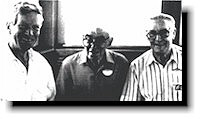
Three Sydney dealers each of whom became life members of ASDA (APTA). From left to right - Kevin Duffy, Max Cohen and Ken Baker. The photograph was taken at Ken Baker's 80th birthday in 1992.
ASDA's relationship with collector organisations became at times a little strained, as the interests of dealers and collectors did not always coincide. For example, a dispute arose over the price of dealers' sales stands at ANPEX, Melbourne's national philatelic exhibition staged in 1950. The Exhibition's President, J.R.W. Purves, was reported as telling his organising committee that "dealers were not material to the Exhibition". This prompted talk of a dealer boycott, but a meeting of ASDA and ANPEX representatives cleared the air and the Exhibition was staged with the Co-operation of the trade. It is interesting to note that ANPEX in 1950 was the first Australian exhibition to involve the trade - previous exhibitions held been organised for collector participation only.
ASDA (APTA) Past Presidents
1948-49 J.M. Phillips (Vic)
1949-52 Frank Thornhill snr. (Vic)
1952-54 Phil Downie (Vic)
1954-56 Max Stern (Vic)
1956-58 Tam Mappin (Vic)
1958-59 G.J.E. Croyston (NSW)
1960-61 F.H. Feibes (Vic)
1961-62 Bill Hornadge (NSW)
1962-63 W.G. Stewart (SA)
1963-64 A.M. Cumming (Vic)
1964-65 Kevin Duffy (NSW)
1965-66 D.B. Moloney (NSW)
1966-68 E. Andersen (Vic)
1968-70 Max Cohen (NSW)
1970-72 G.A. Laker (Qld)
1972-74 Phil Downie (Vic)
1974-76 Kevin Duffy (NSW)
1976-77 Tarn Mappin (Vic)
1977-79 Ray Kelly (Vic)
1979-81 R.J, Grayling (SA)
1981-83 J.A. Thornhill (Qld)
1983-84 Kevin Duffy (NSW)
1984-86 Vince Schofield (Vic)
1986-88 Barry Cooper (NSW)
1988-90 Tony Shields (Vic)
1990-92 Ian Kitchin (Vic)
1992-93 Simon Dunkerley (Vic)
1993-95 Paul Walker (Vic)
1995-97 Alan Pitt (NSW)
1997-99 John Macdonald (Vic)
1999-01 Rod Perry (Vic)
2001-05 Tony Shields (Vic)
2005-09 Michael Eastick (Vic)
2009-11 Tony Shields (Vic)
2011-12 Michael Eastick (Vic)
2012- Stewart Robbins (Qld)
The establishment in 1953 of the Post Office's Philatelic Bureau in Melbourne to handle mail order philatelic sales and the introduction of over-the-counter philatelic sales in capital city GPO's, offered the stamp trade better facilities for acquiring suitable stocks of Australian new issues. At ASDA's October 1949 meeting complaints were aired about the bad centering of recent stamps, which was attributed to "poor quality girl labour who were careless in their handling of the sheets" at the Note Printing Branch! Following his appointment in November 1951 as the Post Office's first Philatelic Officer, Phil Collas told ASDA members that the Philatelic Bureau would not be a competitor to dealers, but would provide "the best possible service to dealers and collectors".
Not all aspects of the Post Office's new activities met with ASDA's approval. The introduction of official first day covers in 1954 (even though these were of a generic type unrelated to the subjects of new stamp issues) was opposed by ASDA, as these items would "interfere with private business". Nevertheless, the Association urged the Post Office to introduce trade discounts for bulk purchases of official first day covers, when it became apparent that their introduction would proceed. The abolition of imprints from stamp sheets in 1952 was opposed by ASDA, but the Postmaster-General, H.L. Anthony's response to the Association said that the decision had been "made after consulting the Philatelic Societies in Sydney and that he does not consider altering his views on the matter."
ASDA, of course, existed to protect the interests of its member dealers and, to this end, the Association resented intrusions into the market place by those who were not considered to be legitimate stamp dealers. There was some equivocation about part-time dealers who did not rely on the stamp trade as their primary source of income, but part-time dealers were admitted to ASDA membership. The Association, however, refused to admit State and Federal public servants involved in part-time stamp dealing.
Remunerative activities outside the workplace were prohibited for public servants and ASDA took strong objection to 'moonlighting' public servants competing against established stamp dealers. Instances of this occurring were reported by ASDA to the government departments concerned. Even the staging of stamp auctions by philatelic societies was objected to by ASDA as encroaching on dealers' activities. Interestingly, these auctions were called a 'Sale by Tender' since the law did not allow public auctions to be held after daylight hours.
A primary concern of stamp dealers during the 1950s was import restrictions imposed by the Australian government. The monetary value of stamps that could be imported into Australia by dealers was fixed and import licences on a cash basis were issued by the Customs department.
For the year 1953, £6,000 worth of licenses were issued to ASDA's 30 members. This represented an average of £200 worth of imported stamps and accessories for each dealer. If a dealer's cash license was used up during the year, he had to resort to bartering stamps for stamps with his counterpart overseas, if this was possible. The system was obviously an impediment for stamp dealers, particularly those whose trading was heavily dependent on foreign new issues and overseas-produced accessories. Efforts by ASDA to make cash licences more generous were invariably unsuccessful, as the Customs department resisted making concessions. Import restrictions on stamps were not removed until 1959.
Until about 1954, the Australian government's Trade Commission Offices in the United States and Canada sold Australian stamps at face value to dealers and collectors. This was resented by ASDA since the system interfered with efforts of its members to sell or barter Australian new issues with overseas dealers. However, a year or so after the establishment of the Philatelic Bureau in Melbourne, the sale of stamps by the Trade Commission Offices ceased.
The first meeting of ASDA in Sydney took place in October 1954 at the Wentworth Hotel. This was followed by the first ASDA dealers' bourse, which was attended by 41 full-time and part time dealers. The Sydney venture encouraged several NSW dealers to apply for membership.
Within five years, a Sydney chapter of ASDA began meeting every two months. The 1954 Sydney meeting was also notable for the appearance of Gypsey Rose Lee, the American stripper, who was then touring Australia. She came to the ASDA meeting because she was a collector herself The Association presented a stockbook containing Australian imprint blocks to Gypsey Rose Lee " who was quite obviously very pleased with her gift."
More importantly at the Sydney meeting, ASDA resolved to create the 'A' List of dealers and collectors "who offended against the trade". Over the years, this confidential list has provided ASDA members with an important means of protecting their businesses against those who might act in an unscrupulous manner. The 'A' List did not prevent Association members from doing business with anyone listed, but dealers were "advised to exercise all caution" if doing so.
In other initiatives to regulate the stamp trade, ASDA suggested to the Post Office in 1955 that it consider licensing stamp dealers. It was not possible to agree to this suggestion, as the Postmaster General replied that to license dealers would require a special Act of Parliament; ASDA urged the Australian Stamp Monthly not to accept advertisement from unknown dealers unless two satisfactory trade references were provided. This suggestion too was rejected by the Magazine's publishers. A non-member dealer advertised cancelled-to-order stamps as 'fine used' and ASDA's efforts to stop this were not successful - the dealer concerned refused to change his ad. Instances of bogus stamps being advertised, but not fully described as such, caused ASDA to give attention to these matters. A collector who acquired 'office mix' stamps for charity resale was reported to be keeping the proceeds for himself and selling uncancelled stamps back to the Post Office.
During the 1950's, ASDA published a quarterly newsletter for distribution to its members as a means of publicising is decisions and activities. This also carried news of dealers' doings. In January 1953, Stewart's Stamp Shop in Adelaide suffered £500 worth of uninsured damage when the shop was flooded out in a deluge. This was caused by blocking of a waste pipe above the shop by a pigeon's nest.
ASDA continued to meet monthly in Melbourne at either Scott's Hotel or the Masonic Club. The amount of business became too much for the meetings to deal with and a committee of four was established in 1955 to deal with routine matters and make recommendations to the monthly meeting. In 1956, ASDA produced the first membership certificates for shop display. The certificates were numbered in alphabetical sequence for charter members and other members' certificates were numbered in seniority order.
By 1956, the membership of ASDA stood at 49 stamp dealers. This comprised 43 Australian dealers and three each from New Zealand and the rest of the world. It was reported then that ASDA embraced nearly all full-time dealers in Australia. In less than a decade after its formation, the Association had reached an impressive level of achievement and it has continued to successfully advance the interests of the philatelic trade in Australia and New Zealand.
APTA's ROLL OF HONOUR
Honorary Life Members
Max Stern
Albert Isaacs
Ken Baker
Kevin Duffy
Paul Walker
Bill Hornadge
Tony Shields
Gerd Kratzer
How to contact APTA
You can contact the Australasian Philatelic Traders' Association by clicking at this link: Contact APTA
Alternatively, APTA's postal address is : PO Box 1186, Mount Ommaney, QLD, 4074, Australia.